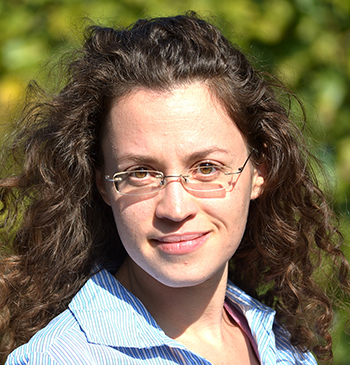
Shira Klein
Even after using testimony in her teaching and research for several years, Professor Shira Klein still discovered something new during her tenure as the USC Shoah Foundation Center for Advanced Genocide Research 2016-2017 International Teaching Fellow.
The annual International Teaching Fellowship is open to professors who wish to incorporate testimony into their courses and research. The chosen fellow has the opportunity to visit the Center and consult with its staff and gives a public lecture at USC about their work.
Klein visited the Center last week to collaborate with staff on how to better incorporate testimony into two classes she teaches at Chapman University: an existing undergraduate course “Jewish Life from Napoleon to Hitler” and a new graduate course “Jewish Migration and War.”
She’s already had students watch testimony in the Visual History Archive in her undergraduate course for the last five years, but during her visit last week she made a discovery that she said will vastly improve their experience searching the archive: how to use the Visual History Archive’s database of over 64,000 indexing terms (keywords) to help students discover topics that interest them.
“Oftentimes students don’t know what they want to write about and there are 54,000 interviews and they’re completely overwhelmed,” Klein said. “Now I’m going to tell students before you do anything, go into the Index search, which shows a whole range of topics, some of which are really creative. Index search is great because it gives them a whole list of ideas that they might be interested in and they can narrow down their search from there.”
Klein intends to show pre-selected clips to her students in addition to assigning them an individual research project. Students will search the archive to find testimonies that interest them and write research papers about how the testimonies relate to the course themes.
During her visit to the Center, Klein also found testimonies that will inform her own research about Italian Jews during the Holocaust.
As part of her research, Klein seeks to dispel the popular myth that Italians were benevolent toward their Jewish neighbors. Klein argues, along with other scholars, that Italians did indeed cooperate with the Nazis to help round up Jews – and testimony in the Visual History Archive supports her theory.
Klein discovered that about one quarter of the testimonies of Italian Jews in the Visual History Archive mention being betrayed.
“That was a strong finding,” Klein said.
She will incorporate this testimony into her forthcoming book about the history of Italian Jews from the late 19th century to the 1950s. Klein also regularly shows testimony clips in her academic presentations.
Testimony is a uniquely valuable source to her both as a teacher and scholar, Klein said. Students and researchers don’t need to have the funds to travel to Europe or speak another language in order to hear first-person accounts from European Jews themselves.
“This is something [students] can do from their laptops in English and it’s just as good a primary source as any other,” Klein said. “It provides a daily life perspective which is something often missing from official sources. This gives you the nitty-gritty of Jewish life in Europe and it gives us the voice of the Jews.”